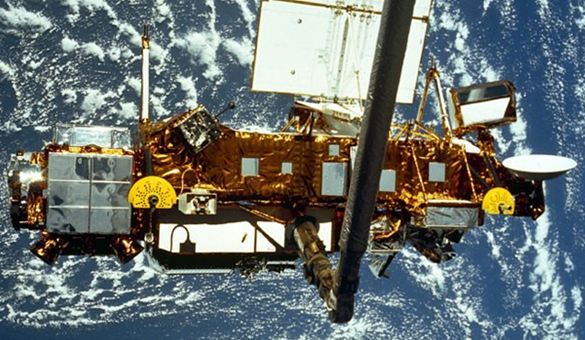 A 6-ton NASA satellite on a collision course with Earth clung to space Friday, apparently flipping position in its ever-lower orbit and stalling its death plunge. The old research spacecraft was targeted to crash through the atmosphere sometime Friday night or early Saturday, putting Canada and Africa in the potential crosshairs, although most of the satellite should burn up during re-entry. The United States was not entirely out of the woods; the possible strike zone skirted Washington state.
A 6-ton NASA satellite on a collision course with Earth clung to space Friday, apparently flipping position in its ever-lower orbit and stalling its death plunge. The old research spacecraft was targeted to crash through the atmosphere sometime Friday night or early Saturday, putting Canada and Africa in the potential crosshairs, although most of the satellite should burn up during re-entry. The United States was not entirely out of the woods; the possible strike zone skirted Washington state.“It just doesn‘t want to come down,” said Jonathan McDowell of the Harvard-Smithsonian Center for Astrophysics. McDowell said the satellite’s delayed demise demonstrates how unreliable predictions can be. That said, “The best guess is that it will still splash in the ocean, just because there‘s more ocean out there.”
Until Friday, increased solar activity was causing the atmosphere to expand and the 35-foot, bus-size satellite to free fall more quickly.
However, late Friday morning, NASA said the sun was no longer the major factor in the rate of descent and that the satellite’s position, shape or both had changed by the time it slipped down to a 100-mile orbit.
“In the last 24 hours, something has happened to the spacecraft,” said NASA orbital debris scientist Mark Matney.
NASA said it expected the satellite to come crashing down between 11:45 p.m. and 12:45 a.m. Saturday. It was going to be passing over the Atlantic, Pacific and Indian oceans at that time, as well as Canada and Africa. “The risk to public safety is very remote,” NASA said in a statement. Any surviving wreckage is expected to be limited to a 500-mile swath.
(아주경제 앤드류 이 기자)
Copyright ⓒ Aju Press All rights reserved.


View more comments